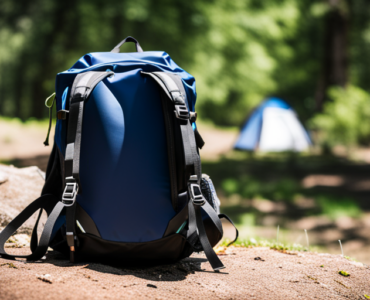Hey there, fellow adventurers! Planning a camping trip soon? Well, you've come to the right place. In this handy guide, I'm going to show you exactly how to properly maintain and care for your camping tent. Believe me, taking good care of your tent is crucial to ensuring a comfortable and problem-free camping experience. So, let's dive in and learn all the tips and tricks to keep your beloved tent in top-notch condition. It's time to make sure you're well-prepared for your next outdoor escapade!
Table of Contents
Quick Tips
Tip 1: Set up your camping tent on a clean and flat surface. Make sure to clear any sharp objects or rocks that could potentially damage your tent's floor. This will help prevent tears and punctures, ensuring a longer lifespan for your tent.
Tip 2: Keep your tent clean by regularly sweeping out dirt and debris. This will prevent dirt from grinding into the fabric, which could lead to wear and tear. Additionally, make sure to dry your tent thoroughly before storing it to prevent mildew and mold growth.
Tip 3: Protect your tent from the sun's harmful UV rays by applying a waterproofing treatment. This will help maintain the tent's integrity and prevent water from seeping through during rainy weather. Remember to follow the instructions provided by the manufacturer for the best results.
Tip 4: Store your camping tent properly to prolong its lifespan. Roll or fold the tent carefully, avoiding sharp creases or bends that could weaken the fabric. Keep it in a cool and dry place, away from direct sunlight, to prevent damage from UV exposure.
Never store your tent while damp or wet to prevent mold and mildew growth
One important thing to remember when it comes to taking care of your tent is to never store it while damp or wet. This is crucial in preventing the growth of mold and mildew, which can not only ruin your tent but also pose potential health risks. So, after your camping trip or outdoor adventure, make sure to take the time to properly dry out your tent before packing it away.
Here are some step-by-step tips on how to do this effectively:
1. Start by finding a dry and well-ventilated area where you can set up your tent. Avoid setting it up under direct sunlight, as this can damage the fabric. Instead, look for a shaded spot with good airflow.
2. Once you have chosen the right spot, remove all the stakes and pegs from your tent and shake out any loose dirt or debris. If you have a rainfly, remove it and keep it separate for now.
3. Next, use a soft-bristle brush or sponge to gently scrub away any stubborn stains or dirt on the tent fabric. Be careful not to scrub too harshly, as this can damage the waterproof coating. Instead, apply gentle pressure and use mild soap or a tent cleaner if necessary.
4. After cleaning the tent, rinse it thoroughly with water to remove any soap residue. It's important to get rid of all the soap, as any leftover residue can attract more dirt or even damage the fabric.
5. Now it's time to dry the tent. Start by hanging it up to air dry. You can use a clothesline, tree branches, or any other sturdy support that can hold the weight of the tent. Ideally, allow the tent to hang until it is completely dry, including the rainfly and any other detachable parts.
6. Finally, before packing the tent away, make sure to check that it is completely dry. Inspect every nook and cranny to ensure there are no remaining damp spots. It's worth taking a few extra minutes to do this, as storing a damp tent can lead to mold and mildew growth, which can be difficult to get rid of.
By following these simple steps, you can take proper care of your tent and ensure its longevity. Remember, a little extra time spent on drying and storing your tent properly can save you from the hassle of dealing with mold and mildew later on. So, always make it a priority to let your tent completely dry before putting it away for your next adventure.
How to Properly Care for Your Tent – Expert Advice – Do's and Don'ts
Regularly inspect your tent for damages and repair them promptly
Regularly inspecting your tent for damages and promptly repairing them is crucial to ensure a successful camping experience. First, begin by setting aside some dedicated time to thoroughly inspect your tent before each trip. Start by examining the tent fabric, checking for any punctures, tears, or holes. If you spot any damage, be sure to repair it immediately to prevent further deterioration. Next, pay close attention to the tent's zippers, as they are prone to wear and tear. Test them to ensure they open and close smoothly. If you notice any issues, lubricate them with a silicone spray or replace them altogether. By conducting these regular inspections, you can address any damages promptly and maintain a safe and secure shelter during your camping adventures.
In addition to inspecting the tent fabric and zippers, it is essential to check the tent poles and stakes. Start by examining the poles for any visible cracks or damage. If you notice any issues, replace the affected pole(s) to ensure the tent's structural integrity. Next, inspect the stakes to make sure they are still sturdy and not bent or rusted. If needed, replace or straighten them to ensure they adequately anchor your tent. Taking the time to inspect and maintain these crucial components will help extend the lifespan of your tent and provide a comfortable and safe camping environment.
The final tip is to maintain your tent by regularly cleaning and properly storing it. After each camping trip, clean off any dirt or debris from both the interior and exterior of the tent. Use mild soap, water, and a soft brush to remove stubborn stains or residues. Once clean, allow the tent to fully dry before packing it away. Remember, storing a damp tent can lead to mold and mildew growth, which can significantly damage your tent over time. Store your tent in a cool, dry place, preferably in a breathable storage bag or container, to prevent any potential damages. By following these steps, you'll be well on your way to maintaining a durable and reliable tent for all your camping adventures.
Use a groundsheet or footprint under the tent to protect the floor from abrasions and moisture
Using a groundsheet or footprint under your tent is a crucial step to protect the floor from abrasions and moisture. To begin, lay out your groundsheet or footprint on the ground where you plan to set up your tent. Ensure that it is the same size or slightly smaller than the base of your tent. By doing this, you create a barrier that prevents sharp objects or rocks from puncturing the tent floor, which could lead to leaks or tears. Additionally, the groundsheet acts as a moisture barrier, preventing water from seeping into the tent during rainy or wet conditions.
Next, carefully place your tent on top of the groundsheet or footprint. Make sure the tent is aligned properly and centered on the groundsheet. This will help distribute the weight evenly and provide maximum protection for your tent floor. Once the tent is in position, secure it to the ground using stakes or guy lines as necessary.
Remember to fold any excess groundsheet or footprint under the tent, rather than letting it stick out beyond the edges. This prevents rainwater from pooling between the tent and the groundsheet, which could potentially lead to flooding inside your tent. By following these steps and using a groundsheet or footprint, you can extend the lifespan of your tent by protecting it from abrasions and moisture.
Store your tent in a cool and dry place to extend its lifespan
Keeping your tent in good condition is essential for ensuring its longevity. One important step is to store it in a cool and dry place. When you store your tent in a cool area, you prevent the growth of mold and mildew, which can damage the fabric and compromise the integrity of the tent. Additionally, a cool environment helps to prevent any potential damage caused by extreme heat or fluctuations in temperature. By finding a dry spot to store your tent, you also minimize the risk of moisture buildup and the formation of rust on any metal parts, such as zippers or tent poles.
To get started, choose a storage location that provides a consistent temperature and minimal exposure to sunlight. You can consider storing your tent in a basement, garage, or an attic, as long as these areas remain cool and dry. Avoid areas prone to high humidity levels, such as a laundry room or bathroom, as well as places where temperatures can fluctuate quickly, such as a shed or outbuilding without insulation.
Once you've found a suitable storage location, take the necessary steps to protect your tent while it's not in use. First, make sure your tent is completely dry before storing it. If you pack a wet or damp tent, it could lead to the growth of mildew, which will not only damage the fabric but also create an unpleasant odor. After ensuring your tent is dry, fold it carefully and loosely to prevent any creases or stress on the fabric. Finally, place the folded tent in a breathable storage bag or wrap it in a clean cotton sheet to protect it from dust and pests while allowing air circulation. Following these simple steps will help ensure that your tent remains in great shape and is ready for your next outdoor adventure.
Conclusion
Finally, you need to take proper care of your camping tent not only to keep it in good condition, but also to make your camping trip as enjoyable and safe as possible. By following these simple steps, such as cleaning your tent after every trip, ensuring it is fully dry before storing, and regularly inspecting for damages, you can ensure that your tent remains in the best possible condition for years to come. Not only will this save you money in the long run, but it will also improve your camping experience by providing a clean and safe shelter. So, make it a habit to care for your tent, and you'll be able to enjoy many more unforgettable camping adventures.
FAQ
FAQ: How To Properly Maintain And Care For Your Camping Tent
Q1: How often should I clean my camping tent?
A1: It is recommended to clean your camping tent after every use or at least once a season to prevent debris, dirt, and moisture from damaging the fabric.
Q2: Can I put my camping tent in the washing machine?
A2: No, it is not advisable to put your camping tent in a washing machine. The agitator and spin cycle can damage the fabric and seams. Instead, hand wash it with a mild soap solution and a soft brush or sponge.
Q3: How do I remove mildew or mold from my tent?
A3: To remove mildew or mold, create a solution of equal parts water and vinegar. Gently scrub the affected areas with a sponge or soft brush. Rinse thoroughly and allow the tent to dry completely before storing.
Q4: Should I store my tent in its carry bag?
A4: Storing your tent in its carry bag is not ideal, as it may compress the fabric and seams, leading to mold or mildew growth. Instead, store your tent loosely in a cool, dry place to allow proper air circulation.
Q5: How can I prevent damage to the tent floor?
A5: To protect the tent floor, always use a ground cloth or footprint underneath. Trim any protruding twigs or rocks that may cause punctures, and sweep the tent floor regularly to avoid abrasion from dirt or sand.
Q6: What should I do if my tent poles get bent or damaged?
A6: If your tent poles get bent or damaged, you can attempt to straighten them using gentle pressure. However, replacement poles are often available from the manufacturer, and it's advisable to invest in new ones to ensure the tent's stability.
Q7: How can I keep animals and pests away from my tent?
A7: To deter animals and pests, avoid bringing food into the tent or storing it in your backpack. Hang food in a bear bag or use bear-resistant containers kept a good distance from your tent to prevent attracting wildlife.
Q8: Can I repair small tears or holes in my tent myself?
A8: Yes, small tears or holes in your tent can be repaired using a tent repair kit, which includes patches, glue, and instructions for application. Follow the provided guide carefully to ensure a secure and lasting repair.
Q9: Should I waterproof my tent regularly?
A9: While modern tents generally come pre-treated with waterproof coatings, it is recommended to reapply a waterproofing treatment every 1-2 years or when you notice water is no longer beading on the fabric.
Q10: How can I extend the lifespan of my tent?
A10: Regular maintenance, proper cleaning, and careful storage can significantly extend the lifespan of your camping tent. Additionally, using a footprint, avoiding sharp objects near your tent, and setting it up on flat ground can also help preserve its longevity.










Add comment